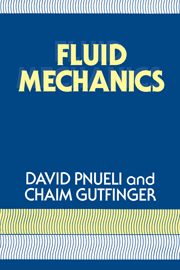Book contents
- Frontmatter
- Contents
- PREFACE
- 1 INTRODUCTION
- 2 STRESS IN A FLUID
- 3 FLUID STATICS
- 4 FLUIDS IN MOTION – INTEGRAL ANALYSIS
- 5 FLUIDS IN MOTION – DIFFERENTIAL ANALYSIS
- 6 EXACT SOLUTIONS OF THE NAVIER–STOKES EQUATIONS
- 7 ENERGY EQUATIONS
- 8 SIMILITUDE AND ORDER OF MAGNITUDE
- 9 FLOWS WITH NEGLIGIBLE ACCELERATION
- 10 HIGH REYNOLDS NUMBER FLOWS – REGIONS FAR FROM SOLID BOUNDARIES
- 11 HIGH REYNOLDS NUMBER FLOWS – THE BOUNDARY LAYER
- 12 TURBULENT FLOW
- 13 COMPRESSIBLE FLOW
- 14 NON-NEWTONIAN FLUIDS
- APPENDIXES
- INDEX
5 - FLUIDS IN MOTION – DIFFERENTIAL ANALYSIS
Published online by Cambridge University Press: 05 June 2012
- Frontmatter
- Contents
- PREFACE
- 1 INTRODUCTION
- 2 STRESS IN A FLUID
- 3 FLUID STATICS
- 4 FLUIDS IN MOTION – INTEGRAL ANALYSIS
- 5 FLUIDS IN MOTION – DIFFERENTIAL ANALYSIS
- 6 EXACT SOLUTIONS OF THE NAVIER–STOKES EQUATIONS
- 7 ENERGY EQUATIONS
- 8 SIMILITUDE AND ORDER OF MAGNITUDE
- 9 FLOWS WITH NEGLIGIBLE ACCELERATION
- 10 HIGH REYNOLDS NUMBER FLOWS – REGIONS FAR FROM SOLID BOUNDARIES
- 11 HIGH REYNOLDS NUMBER FLOWS – THE BOUNDARY LAYER
- 12 TURBULENT FLOW
- 13 COMPRESSIBLE FLOW
- 14 NON-NEWTONIAN FLUIDS
- APPENDIXES
- INDEX
Summary
Differential Representation
Two conditions must be satisfied to make the integral analysis considered in the previous chapter useful: The sought information must be such that no details are required; and enough information must be known a priori to supply numerical values for all the symbols in the equations of the integral analysis. In many situations details are meaningful and necessary, and in very many cases, particularly engineering ones, no a priori information is given.
The difficulty mentioned in Chapter 4, that of identification of fluid particles, cannot be alleviated any more by an integral approach and the concept of the field must be introduced.
The field point of view, which is traditionally called the Eulerian approach, uses the same properties associated with fluid particles, e.g., density, velocity, temperature, etc., but assigns them to the field. One then considers the field density, i.e., the density at a particular point (x, y, z) and at a particular time, or one considers the field velocity or the field temperature. There is then a flow field, with all its properties at each point and for any time, and the problem of identification seems to have been successfully circumvented.
There is still, however, an intermediate step necessary before field analysis can be applied: the basic laws dealing with mass and momentum, which are formulated for well-defined, and therefore identifiable, thermodynamic systems, must be translated into expressions which contain field concepts only. An analogous step has been taken in going from thermodynamic systems to control volumes in Chapter 4.
- Type
- Chapter
- Information
- Fluid Mechanics , pp. 141 - 178Publisher: Cambridge University PressPrint publication year: 1992



